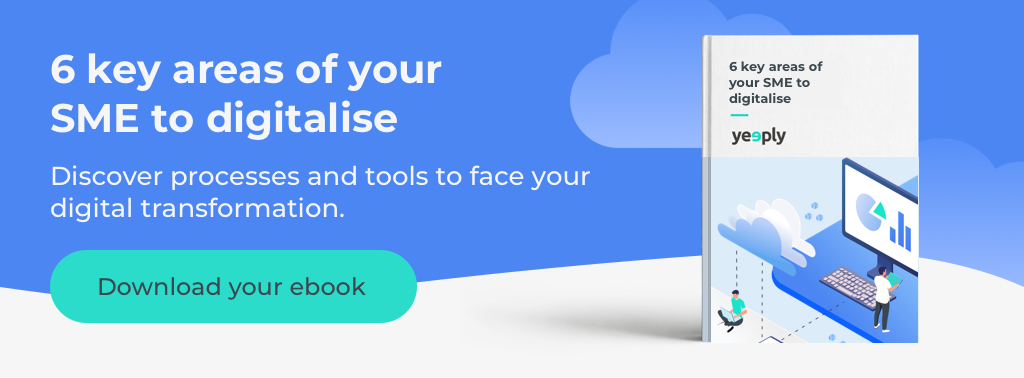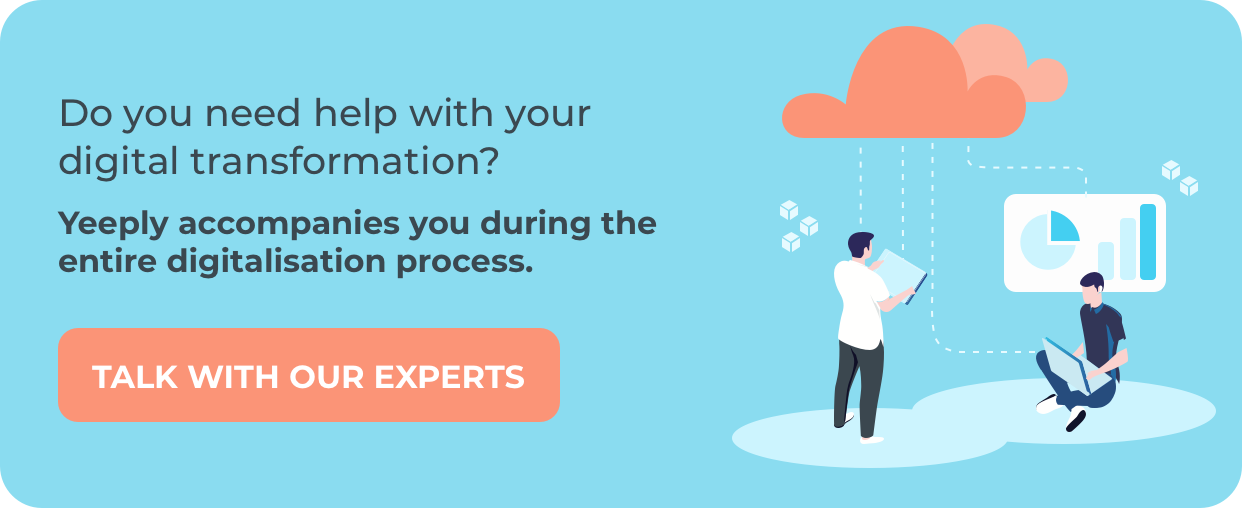The digital transformation of companies implies a mind-set change within an organisation. It goes beyond simply incorporating technology: along with its deployment, the company’s processes must be reviewed to adapt them to the new customer and environmental demands.
Yeeply is willing to help you obtain some inspiration. We’ll now show you several examples of digital transformation in benchmark companies.
5 Digital transformation examples

⚡ Related article | Interview with Héctor Badal (Yeeply) – How to take advantage of Digital Transformation in the post Covid-19
SEAT
The Spanish car manufacturing company has been investing in digitisation for years and aims to become an industry 4.0 benchmark. The company launched its Breaking Fab innovation programme within its digital transformation strategy as early as 2017.
SEAT sought to attract talent through it by inviting start-ups, students, designers and researchers to solve some of the challenges it faced in the manufacturing process.
To keep on making progress with its digital transformation, the Spanish company has set up a software development centre. The centre is called Seat: CODE (with CODE standing for “Centre of Digital Excellence”) and aims to improve the company’s efficiency by digitalising its processes and developing new business models.
SEAT wants to be more than a car manufacturer: it aims at being a reference for future mobility. Therefore, the carmaker will look for new business lines focused on connectivity, car digitalisation and new mobility concepts.
This commitment to business digitalisation has already been recognised by the Financial Times, who has included the Spanish manufacturer in its top-100 ranking of European companies leading digital transformation.
Recommended article: Implementing the Customer Data Platform (CDP) in your digital transformation
Lego
Lego was founded in 1932 and its iconic pieces have been unmistakable ever since. However, the truth is that the company has been through difficult times despite its enormous success and being extremely well-known worldwide.
Following an expansion in the 1970s, the company’s turnover began to decrease eventually in the 1990s until it became on the verge of bankruptcy in 2004. This became a watershed moment for the company and was when its restructuring and digital transformation began.
Lego opted for diversifying its business model. From that moment onwards, it began to develop other business lines — on top of selling toys — focused on the digital world: movies, video games, mobile games, apps, etc.
One of the apps they developed was Lego Digital Designer, which enables designing your own Lego structures. This software allows you to make construction design guides and share your creations with other fans. Lego has managed to focus its value proposition beyond entertainment and towards learning and education.
Some examples are Lego Serious Play (a powerful tool designed to enhance innovation and business performance), or First Lego League (an international competition aimed at high school students worldwide who must offer solutions to a scientific challenge).
L’Oréal
A century-old beauty company such as L’Oréal has also been capable to adapt to the digital world without forfeiting its essence. Taking a step beyond its innovative and extensive range of products, the French company has also taken advantage of the possibilities offered by digital environments to create new meeting spaces with its customers.
Creating apps has been another of its preferences within its digital transformation strategy. Virtually Makeup App, for instance, allows you to envisage how you will look like with a given makeup by using augmented reality. Something similar happens with Style My Hair, an app for checking how changing your hair colour will be like before actually dropping by the hairdresser.
Wearables are another line in which L’Oréal has been launching some projects. My UV Patch is a patch that measures sun exposure and was released in 2016. Moreover, the company went a step further in 2018 by launching UV Sense, a battery-free wearable device capable of measuring ultraviolet radiation. It works alongside an app that tells users when to avoid sun exposure and apply sunscreen again.
Learn how My UV Patch is working, in this video:
Muroexe
Muroexe is an atypical shoe company. It was created in 2013 by two digital marketing professionals and sells shoes designed following an urban and formal style. Its customers are mainly in their 30s or early 40s, city dwellers, and looking for comfortable, elegant shoes to use every day.
The brand’s first models were devised by a team of engineers, biomechanics experts, materials technicians and industrial designers. Muroexe has already sold more than 250,000 pairs and its turnover estimate for 2020 surpasses EUR 6 million. Where does a significant share of its success lie? Well, in putting its customers at the very heart of its strategy.
To keep on growing, Muroexe has opted for listening to its customers. Several of its models have been designed following what customers have been requesting in surveys. And this has become a permanent aspect of its course of business. The company raises new business lines, product improvements or ideas for new models through its website’s Design Lab section.
Keep reading: Top 10 Digital Transformation Trends for 2021
BMW
BMW is an example of how a legendary car brand can climb on the bandwagon of the collaborative economy. DriveNow is a BMW and Mini car-sharing service to promote sustainable mobility. It also includes BMWi electric models.
In this video, the concept of DriveNow is explained in 60 seconds:
https://youtu.be/6hrfPY8sn9E
The idea behind it is quite simple: pick it up anywhere and return it anywhere. The price of the service is billed per minute and includes fuel and parking costs. Civil liability insurance is also included, so the customer won’t have to go through monthly or annual insurance fees.
The service is already a success in Germany, where it’s currently operational in 5 cities. Besides, it’s already in use in other European cities such as Vienna, London, Copenhagen, Brussels, Milan, Helsinki, Lisbon and Budapest.
Find out more: 9 Ways IoT Will Transform The Retail Industry in 2021
Digital transformation in companies: a present challenge
What do you think of the previous digital transformation examples? Not all of them may belong to your industry or be large companies.
However, to face your company’s digital transformation successfully, you must stick to the main concepts: kick off a mind-set change, streamline your processes and place the customer at the heart of it all. It’s high time to get started.
Did these examples of digital transformation for companies inspire you? Yeeply can help you build up a successful digital transformation strategy. Tell us about your idea and we will advise you about the solution which best suits your business.













